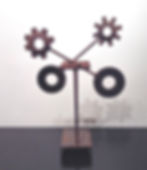
$1,400 Kinetic Sculpture signed, 1981 steel - 4 parts 19" x 12.5" x 6"

$1,200 Kinetic Sculpture signed, 1979 steel - 4 parts 20" x 12.5" x 6"

SOLD Kinetic Sculpture signed, 1985 steel - 4 parts 23" x 6" x 5"

SOLD Circle Three Kinetic sculpture signed 2002 steel (4 parts) 62" x 32" x 10"

SOLD Untitled Kinetic Sculpture signed 1977 steel (3 parts) 17.5" x 9" x 7"

SOLD Kinetic Sculpture signed, 1977 iron - 3 parts 19.5" x 4" x 5"
Bruce Stillman
Bruce Stillman, noted kinetic sculptor, was born in St Louis Park, MN, in 1958. Although Stillman began constructing kinetic sculptures at the age of 16 and had an independent livelihood through his art sales by the age of 18, he spent a year of formal study at Northern Illinois University in 1980 and used the services available through the Minneapolis College of Art and Design Extension, and the University of Minnesota Extension.
Initially, Stillman used brass and copper as his medium of choice; he is now known best for his works in stainless steel. Although light and shadow, negative and positive space, depth and perspective, texture and form are important, Stillman considers motion a prime element to his sculptures. He said, “I approach motion as an added dimension to 3-dimensional sculpture and interpret my style of motion as having a lively energy, playing with gravity. I’m interested in the art of pleasant motion, a slow tranquil motion that in some viewer’s judgment is relaxing, almost hypnotic to watch.”
Indoor sculptures are up to five feet in height, while outdoor pieces can be monumental, exceeding 15 ft. in height and 85 ft. in length.
Stillman’s works have been featured in Vogue Magazine, CBS Morning news and People magazine and they can be viewed in private, corporate, and international settings such as General Mills, Lutheran Brotherhood Insurance, Mayo Clinic and Dayton-Hudson Corp. Prominent private collectors include movie Producer and Director Robert Altman, artist Yaacov Agam, Henry Mancini and more. An outdoor kinetic sculpture is in permanent collection of the Kansas City At Institute.
Stillman’s work is often compared with those of Alexander Calder.
